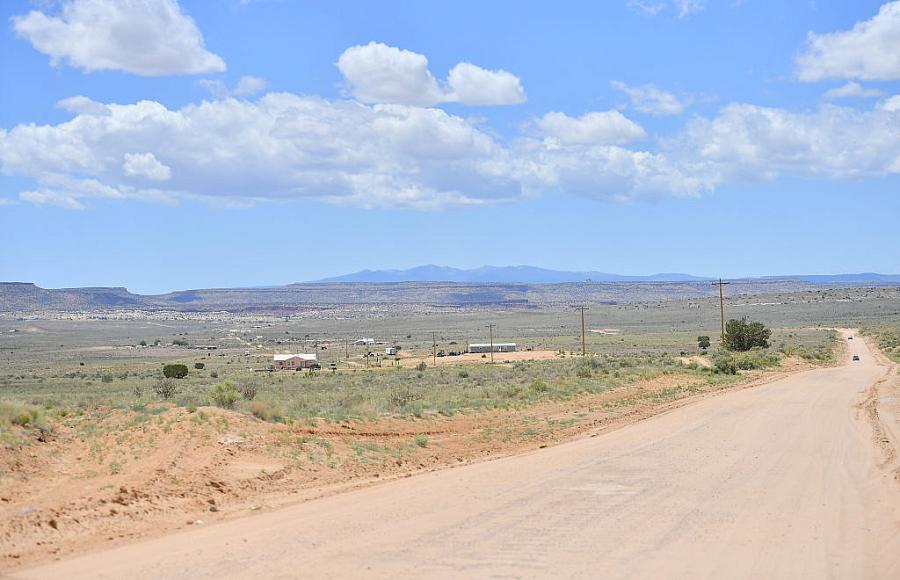Journalists swap strategies for reporting that respects complex communities

Homes on the To’Hajiilee Indian Reservation, New Mexico, part of the Navajo Nation.
(Photo by Sam Wasson/Getty Images)
Journalists tend to see their mission as shining a spotlight on problems, whether it’s government ineptitude, infection hotspots, or long arcs of grinding poverty or violence.
But for the people living in communities bearing the brunt of these problems, the media’s seeming eagerness to report on the dysfunction or despair can be frustrating at best — and stigmatizing, hurtful and alienating at worst.
Three journalists who have sought to chart a different path in their coverage shared insights this week with journalists attending the Center for Health Journalism’s 2021 National Fellowship, modeling an approach that emphasizes community resilience and complexity amid suffering and devastation.
Anita Hofschneider, a reporter covering social issues for Honolulu Civil Beat, spoke of her enduring frustration with coverage of Pacific Islander communities that doesn’t include voices from the community. In one particularly egregious example, a TV reporter delivered a breathless segment on a Honolulu homeless encampment without bothering to get out of the moving car to talk to those living there. The frame: Why are sidewalk ordinances not being enforced, and who is paying for the water being siphoned out of a city pipe?
“I’ve approached my reporting on this community by recognizing that traditionally in Hawaii’s media ecosystem, there’s a lot of reason to distrust the media because of the ways in which (Pacific Islanders) have been excluded from the narrative, or included but in a way that they don’t feel like is accurate to their own actual experience, or it does not actually reflect their voices,” Hofschneider said.
Her reporting on the impact of COVID-19 on Pacific Islanders in Hawaii as a 2020 Center for Health Journalism National Fellow prominently featured the voices and perspective of the community, resulting in stories that were highly critical of the state’s failure to recognize that Pacific Islanders were at risk of being disproportionate affected by COVID-19.. “It’s unclear why the state didn’t do more to get ahead of the disparities and involve the communities most likely to be impacted by the pandemic in the state’s emergency response,” Hofschneider wrote in one story.
That focus in her coverage on close listening to community voices had an impact. In February, the U.S. Department of Interior, citing her reporting, awarded over $1 million to address COVID-19 disparities in Pacific Islanders in Hawaii.
Broadcast journalists Colton Shone and Nate O’Neal of KOB4 in Albuquerque have also been dismayed at times by insensitive and exploitative coverage of communities in the Navajo Nation. The problem was especially acute early in the COVID-19 pandemic, when Navajo communities were among the hardest hit in the nation, and reporters from seemingly every national media outlet parachuted in to report the story. They pointed to a Vice documentary as a prime example of coverage that offends.
“We were just kind of taken aback by the way that was framed,” O’Neal said. “It started with the shock value, inside a morgue showing bodies, without establishing a more personalized approach — learning who is actually living through this, what are they going through right now.” He added: “It was cringeworthy, to be honest.”
Other coverage was less sensational, but often oversimplified.
“I’m Navajo, Diné, and I’ve always noticed that when it comes to coverage of Native American issues, a lot of people who do identify as Native American find that some of the coverage is unflattering or stereotypical,” said Shone.
The KOB4 team spent six months reporting on the impact of COVID-19 on the Navajo Nation, filing individual stories that were eventually combined in a half-hour documentary, “The People vs. the Pandemic.” They took pains to include in their stories the historical context, which helps explain present-day disparities in access to health care, education and other resources. They sought to show people and images representing the full spectrum of community life.
“Something that we noticed was a tendency to oversimplify a lot of people’s stories on the Navajo Nation, specifically when you’re talking about poverty porn,” O’Neal said. “That was just something we wanted to avoid completely. We wanted to make sure the imagery we put out there was comprehensive and it wasn’t going to stigmatize the experience for an entire people based on the worst of the worst.”
In a follow-up panel discussion, Allie Young, founder of the Indigenous storytelling organization Protect the Sacred, echoed earlier warnings about the harmfulness of “poverty porn.” She said that early in the pandemic, it made sense for media stories to highlight problems such as the lack of running water and electricity. But by the end of the year, she started to grow frustrated. “OK, we know that information. It’s time to tell the stories of resilience and the positive stories of how we were able to take back control of what was happening to our people, and to tell those stories.”
One way she sought to do that was by collaborating with Johns Hopkins University and the nonprofit CORE to produce panel discussions with health experts and tribal leaders. “Tribal Voices from the Pandemic” aired on Gallup Public Radio, as well as public radio stations in Seattle and Minneapolis.
“We just need to take control of our own narrative,” Young said.

